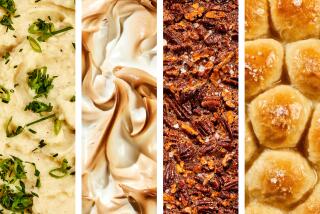Thanksgiving : New England’s Old, Old Food
- Share via
Malabar Hornblower, “The Plimoth Plantation New England Cookery Book,” Harvard Common Press: $10.95.
Like Old England, New England treasures its traditions, perhaps especially when outsiders have a hard time seeing the point. As a result there have been plenty of New England cookbooks and it’s no great problem to find a recipe for boiled dinner, Indian pudding or blueberry grunt.
New England treasures its traditions so much that Massachusetts has the most systematic historical park in the country, Plimoth Plantation. Instead of performing historical demonstrations, its staff carries on as if they were living in the real town of Plymouth in the year 1627, going about everyday household chores and speaking 17th-Century dialect. If you try to talk to them about automobiles and electric lights, they claim not to understand and accuse you of suffering from strange humors.
This “living museum” was founded by Malabar Hornblower’s husband, and this book, which she wrote with the staff of Plimoth Plantation, promises to go far beyond brown bread and codfish balls. It begins with a scholarly introduction about the cookery of the Pilgrims (with a lot of fascinating material about the First Thanksgiving, of course) and continues with 16 dishes the Pilgrims probably cooked. The recipes--from 16th- and 17th-Century English books--do not much resemble modern New England food. They tend to be savory and spicy, if heavy: a minced pie of chicken, a minced pie of lamb, stuffed fish, prune tart.
I think most of us would like to taste what people ate long ago . . . at least once. The fish boiled with herbs and vinegar and the chicken with a spiced cream sauce do sound very good, and even that stuffed fish (despite its name, “tench with a pudding in her belly”). Though a historian might object, Hornblower has lightened and modernized some of these recipes. Her pease porridge, for instance, is made with fresh rather than dried peas, which sounds like a definite improvement.
Following this is a chapter you really won’t find anywhere else: seven dishes of the Wampanoag Indians of Cape Cod, reconstructed from old manuscript descriptions. These are not what we would call refined--several are simply corn meal boiled with other ingredients--but as Hornblower points out, the available recipes are very rudimentary and there must have been lots of unrecorded Wampanoag kitchen lore, which might have made a difference. They do have a rough, archaic charm, though.
The rest of the book represents modern New England, and here it does not go much beyond the usual dishes. Though it’s true that not every book gives a recipe for pan-fried codfish cheeks, we mostly find just what we’d expect: clam chowder, baked beans, all the peculiar-sounding desserts like duffs and slumps (including the unjustly overlooked cottage pudding: not a pie but essentially a cake baked on top of a fruit pudding).
The question is: Exactly why should we go to Plimoth Plantation for them? I’m not quite sure, though they do seem to be good recipes. The baked beans recipe came from the Durgin-Park Restaurant, for instance, and it does make sense to bake turnips with maple syrup, even if they come from the supermarket rather than your own root cellar.
As Hornblower points out, New England has welcomed (well, perhaps with a certain reserve) the dishes of immigrants, particularly the Portuguese and the Italians, and she gives recipes for kale soup, a New Englandized cioppino and so on. She neglects, however, to spell out latest immigrant group--New Yorkers--though I see their distinct influence. You can’t tell me minted zucchini with yogurt came over on the Mayflower.


